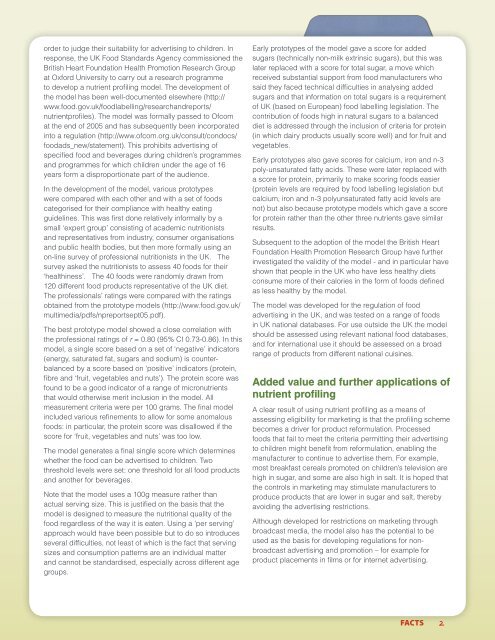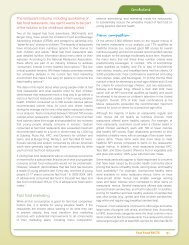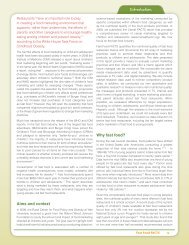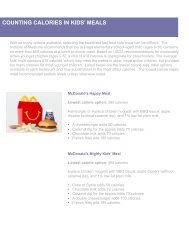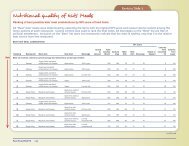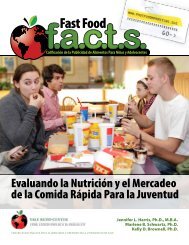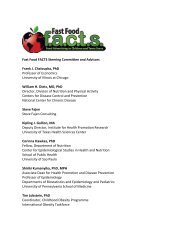What sort of nutrient profiling model? The UK ... - Fast Food FACTS
What sort of nutrient profiling model? The UK ... - Fast Food FACTS
What sort of nutrient profiling model? The UK ... - Fast Food FACTS
You also want an ePaper? Increase the reach of your titles
YUMPU automatically turns print PDFs into web optimized ePapers that Google loves.
order to judge their suitability for advertising to children. In<br />
response, the <strong>UK</strong> <strong>Food</strong> Standards Agency commissioned the<br />
British Heart Foundation Health Promotion Research Group<br />
at Oxford University to carry out a research programme<br />
to develop a <strong>nutrient</strong> pr<strong>of</strong>iling <strong>model</strong>. <strong>The</strong> development <strong>of</strong><br />
the <strong>model</strong> has been well-documented elsewhere (http://<br />
www.food.gov.uk/foodlabelling/researchandreports/<br />
<strong>nutrient</strong>pr<strong>of</strong>iles). <strong>The</strong> <strong>model</strong> was formally passed to Ofcom<br />
at the end <strong>of</strong> 2005 and has subsequently been incorporated<br />
into a regulation (http://www.<strong>of</strong>com.org.uk/consult/condocs/<br />
foodads_new/statement). This prohibits advertising <strong>of</strong><br />
specified food and beverages during children’s programmes<br />
and programmes for which children under the age <strong>of</strong> 16<br />
years form a disproportionate part <strong>of</strong> the audience.<br />
In the development <strong>of</strong> the <strong>model</strong>, various prototypes<br />
were compared with each other and with a set <strong>of</strong> foods<br />
categorised for their compliance with healthy eating<br />
guidelines. This was first done relatively informally by a<br />
small ‘expert group’ consisting <strong>of</strong> academic nutritionists<br />
and representatives from industry, consumer organisations<br />
and public health bodies, but then more formally using an<br />
on-line survey <strong>of</strong> pr<strong>of</strong>essional nutritionists in the <strong>UK</strong>. <strong>The</strong><br />
survey asked the nutritionists to assess 40 foods for their<br />
‘healthiness’. <strong>The</strong> 40 foods were randomly drawn from<br />
120 different food products representative <strong>of</strong> the <strong>UK</strong> diet.<br />
<strong>The</strong> pr<strong>of</strong>essionals’ ratings were compared with the ratings<br />
obtained from the prototype <strong>model</strong>s (http://www.food.gov.uk/<br />
multimedia/pdfs/npreportsept05.pdf).<br />
<strong>The</strong> best prototype <strong>model</strong> showed a close correlation with<br />
the pr<strong>of</strong>essional ratings <strong>of</strong> r = 0.80 (95% CI 0.73-0.86). In this<br />
<strong>model</strong>, a single score based on a set <strong>of</strong> ‘negative’ indicators<br />
(energy, saturated fat, sugars and sodium) is counterbalanced<br />
by a score based on ‘positive’ indicators (protein,<br />
fibre and ‘fruit, vegetables and nuts’). <strong>The</strong> protein score was<br />
found to be a good indicator <strong>of</strong> a range <strong>of</strong> micro<strong>nutrient</strong>s<br />
that would otherwise merit inclusion in the <strong>model</strong>. All<br />
measurement criteria were per 100 grams. <strong>The</strong> final <strong>model</strong><br />
included various refinements to allow for some anomalous<br />
foods: in particular, the protein score was disallowed if the<br />
score for ‘fruit, vegetables and nuts’ was too low.<br />
<strong>The</strong> <strong>model</strong> generates a final single score which determines<br />
whether the food can be advertised to children. Two<br />
threshold levels were set: one threshold for all food products<br />
and another for beverages.<br />
Note that the <strong>model</strong> uses a 100g measure rather than<br />
actual serving size. This is justified on the basis that the<br />
<strong>model</strong> is designed to measure the nutritional quality <strong>of</strong> the<br />
food regardless <strong>of</strong> the way it is eaten. Using a 'per serving'<br />
approach would have been possible but to do so introduces<br />
several difficulties, not least <strong>of</strong> which is the fact that serving<br />
sizes and consumption patterns are an individual matter<br />
and cannot be standardised, especially across different age<br />
groups.<br />
Early prototypes <strong>of</strong> the <strong>model</strong> gave a score for added<br />
sugars (technically non-milk extrinsic sugars), but this was<br />
later replaced with a score for total sugar, a move which<br />
received substantial support from food manufacturers who<br />
said they faced technical difficulties in analysing added<br />
sugars and that information on total sugars is a requirement<br />
<strong>of</strong> <strong>UK</strong> (based on European) food labelling legislation. <strong>The</strong><br />
contribution <strong>of</strong> foods high in natural sugars to a balanced<br />
diet is addressed through the inclusion <strong>of</strong> criteria for protein<br />
(in which dairy products usually score well) and for fruit and<br />
vegetables.<br />
Early prototypes also gave scores for calcium, iron and n-3<br />
poly-unsaturated fatty acids. <strong>The</strong>se were later replaced with<br />
a score for protein, primarily to make scoring foods easier<br />
(protein levels are required by food labelling legislation but<br />
calcium, iron and n-3 polyunsaturated fatty acid levels are<br />
not) but also because prototype <strong>model</strong>s which gave a score<br />
for protein rather than the other three <strong>nutrient</strong>s gave similar<br />
results.<br />
Subsequent to the adoption <strong>of</strong> the <strong>model</strong> the British Heart<br />
Foundation Health Promotion Research Group have further<br />
investigated the validity <strong>of</strong> the <strong>model</strong> - and in particular have<br />
shown that people in the <strong>UK</strong> who have less healthy diets<br />
consume more <strong>of</strong> their calories in the form <strong>of</strong> foods defined<br />
as less healthy by the <strong>model</strong>.<br />
<strong>The</strong> <strong>model</strong> was developed for the regulation <strong>of</strong> food<br />
advertising in the <strong>UK</strong>, and was tested on a range <strong>of</strong> foods<br />
in <strong>UK</strong> national databases. For use outside the <strong>UK</strong> the <strong>model</strong><br />
should be assessed using relevant national food databases,<br />
and for international use it should be assessed on a broad<br />
range <strong>of</strong> products from different national cuisines.<br />
Added value and further applications <strong>of</strong><br />
<strong>nutrient</strong> pr<strong>of</strong>iling<br />
A clear result <strong>of</strong> using <strong>nutrient</strong> pr<strong>of</strong>iling as a means <strong>of</strong><br />
assessing eligibility for marketing is that the pr<strong>of</strong>iling scheme<br />
becomes a driver for product reformulation. Processed<br />
foods that fail to meet the criteria permitting their advertising<br />
to children might benefit from reformulation, enabling the<br />
manufacturer to continue to advertise them. For example,<br />
most breakfast cereals promoted on children’s television are<br />
high in sugar, and some are also high in salt. It is hoped that<br />
the controls in marketing may stimulate manufacturers to<br />
produce products that are lower in sugar and salt, thereby<br />
avoiding the advertising restrictions.<br />
Although developed for restrictions on marketing through<br />
broadcast media, the <strong>model</strong> also has the potential to be<br />
used as the basis for developing regulations for nonbroadcast<br />
advertising and promotion – for example for<br />
product placements in films or for internet advertising.<br />
<strong>FACTS</strong> 2


